
Overview
This article delves into the transformative potential of Google Analytics' unique users data for direct-to-consumer (DTC) brands, showcasing how it can be harnessed to refine marketing strategies and elevate customer engagement.
Understanding unique users is not merely beneficial; it is essential for tailoring marketing efforts, enhancing conversion rates, and fostering sustainable growth.
Supported by compelling examples of successful implementations and best practices in data analysis, this exploration underscores the critical role of data in driving strategic decisions.
DTC brands that effectively leverage this information position themselves for success in an increasingly competitive landscape.
Introduction
In the dynamic realm of direct-to-consumer (DTC) brands, grasping the nuances of customer engagement has never been more critical. Unique user metrics in Google Analytics provide invaluable insights into the behaviors and preferences of individual consumers, empowering brands to tailor their marketing strategies with precision. As the landscape continues to evolve, DTC companies face the pressing question: how can they adeptly navigate the complexities of tracking unique users amidst challenges like data privacy and shifting consumer expectations? This article explores ten pivotal insights that underscore the significance of unique users, offering actionable strategies for brands striving to enhance engagement and foster sustainable growth.
Parah Group: Optimize Unique User Engagement for DTC Brands
Parah Group stands at the forefront of Conversion Rate Optimization (CRO) for DTC businesses, with a sharp focus on enhancing customer engagement. By leveraging data-informed strategies and insights into consumer behavior, Parah Group empowers companies to better understand their unique clientele, leading to increased conversion rates and higher average order values.
In a competitive landscape where customer acquisition costs are escalating, this optimization becomes indispensable. Implementing session recordings and customer surveys yields invaluable insights into consumer behavior, enabling brands to fine-tune their marketing strategies with precision.
Furthermore, refining checkout processes is critical to reducing cart abandonment rates, thereby enhancing customer engagement. As industry leaders emphasize, fostering authentic interactions with distinct individuals is not merely beneficial; it is essential for driving sustainable growth and profitability in the DTC sector.
Notably, an impressive 93% of consumers find user-generated content (UGC) instrumental in their purchasing decisions, underscoring the significance of genuine engagement in boosting conversions.
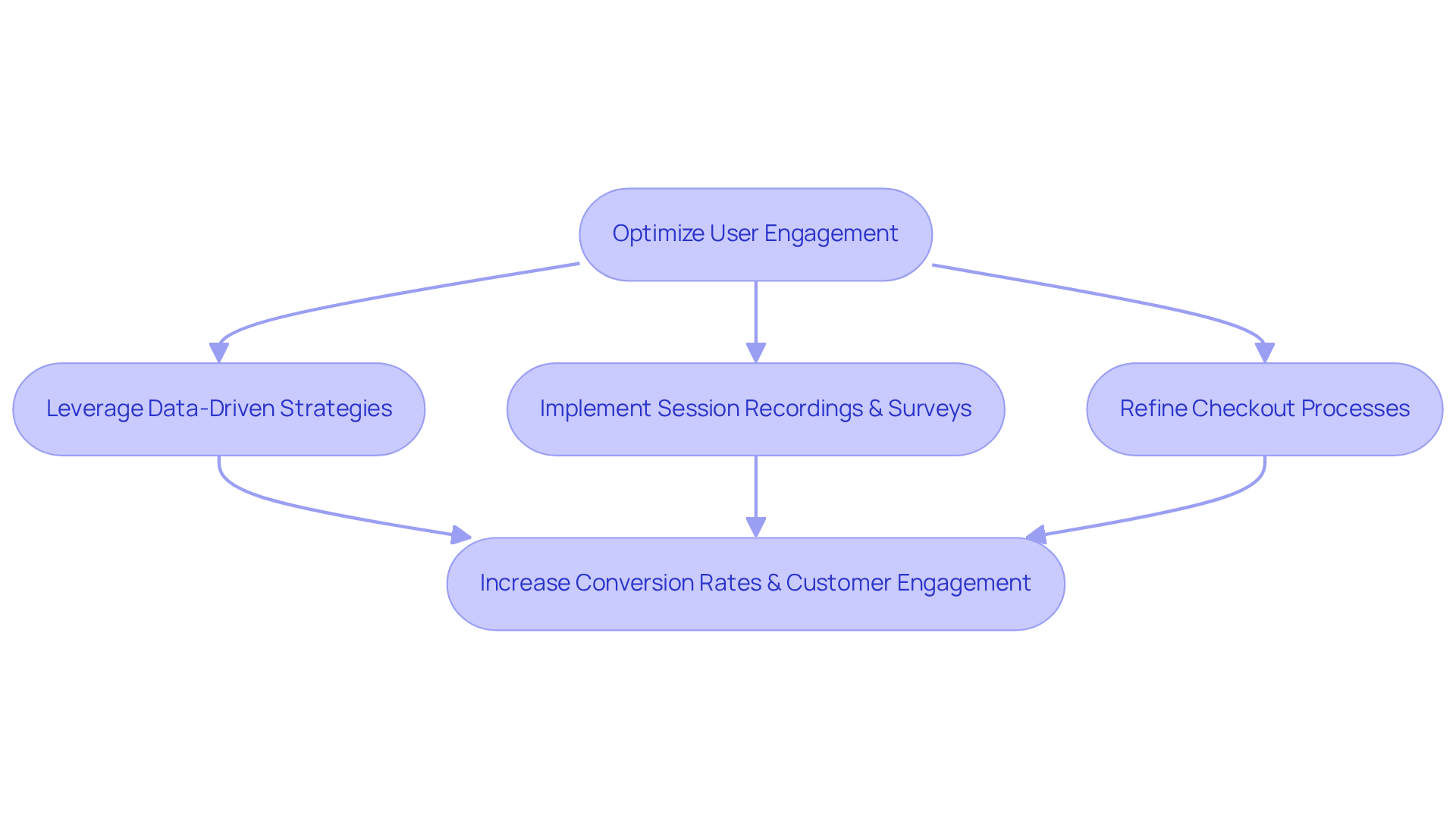
Understanding Unique Users in Google Analytics 4
In Google Analytics 4 (GA4), google analytics unique users are defined as distinct individuals who interact with a website or app within a specified time frame. This metric is crucial for direct-to-consumer (DTC) companies, as it uncovers the true audience size and assists in distinguishing between new and returning visitors. GA4 utilizes an advanced tracking system that merges identifiers and cookies, ensuring precise data collection that mirrors individual behavior over time. Understanding the google analytics unique users metric is essential for companies that want to optimize their marketing strategies and improve audience engagement.
By leveraging distinct consumer data, DTC companies can enhance their marketing strategies, ultimately increasing conversion rates and boosting overall performance. Furthermore, as Parah Group highlights, a comprehensive grasp of distinct individuals allows companies to execute focused conversion rate optimization (CRO) strategies, such as:
- A/B testing
- Audience segmentation
These strategies enhance profitability and promote sustainable growth. This holistic approach ensures that marketing efforts are tailored to meet the specific needs of the audience, leading to more effective engagement and increased conversions.
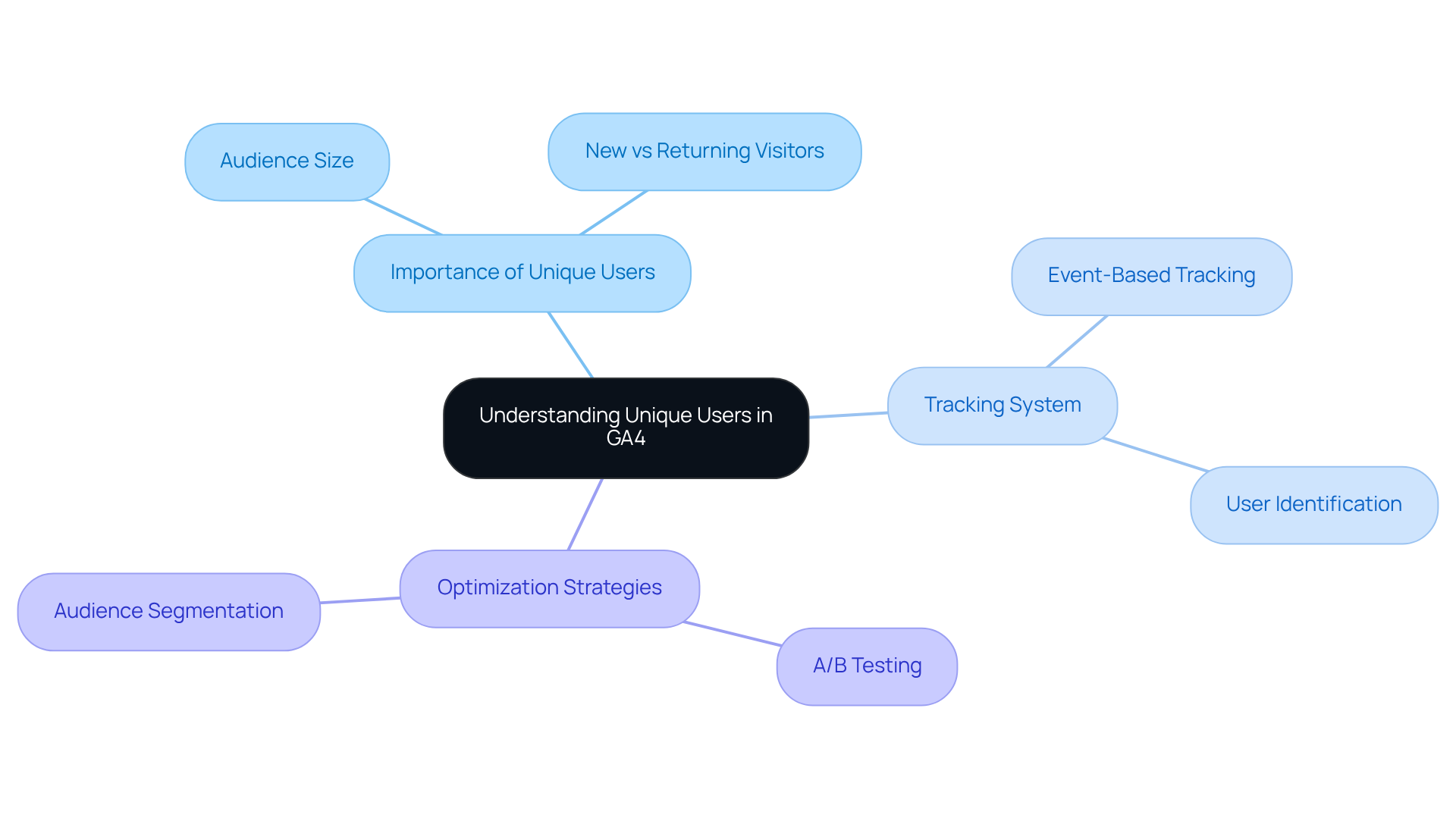
New vs. Returning Users: Implications for DTC Marketing Strategies
Understanding the distinction between new and repeat clients is crucial for DTC companies. New visitors are those exploring the site for the first time, while returning patrons have previously engaged with the company. This differentiation empowers companies to tailor their marketing strategies effectively. For example, new customers often benefit from introductory promotions or educational content that familiarizes them with the company, enhancing their initial experience. Conversely, returning customers typically respond more positively to loyalty programs and personalized recommendations that acknowledge their previous interactions.
Customer segmentation is pivotal in shaping these strategies. By analyzing consumer behavior, companies can identify trends that inform targeted campaigns. Successful DTC companies have launched initiatives specifically designed for new customers, such as:
- Promotional discounts
- Engaging onboarding experiences
These initiatives can significantly boost conversion rates. Simultaneously, strategies aimed at re-engaging customers, such as:
- Exclusive offers
- Feedback-driven product recommendations
can foster loyalty and increase customer lifetime value.
Ultimately, leveraging insights from consumer behavior analytics enables DTC companies to optimize their marketing efforts, enhancing engagement and driving conversions. This tailored approach not only improves customer satisfaction but also fortifies the overall relationship, paving the way for sustainable growth.

Tracking Unique Users Over Time: Insights for Sustainable Growth
Monitoring google analytics unique users over time provides DTC companies with invaluable insights into audience expansion and interaction trends. By thoroughly examining trends in participant data, including google analytics unique users, companies can pinpoint peak engagement times, assess the effectiveness of their marketing campaigns, and make informed, data-driven decisions to enhance the participant experience. This longitudinal analysis is crucial for sustainable growth, as it empowers companies to adapt their strategies based on the behavior and preferences of google analytics unique users, ultimately leading to improved conversion rates and increased customer loyalty.
For example, the Parah Group's collaboration with a $30M apparel label resulted in a remarkable 35% increase in conversion rates following the optimization of their homepage and the implementation of innovative strategies such as gamified progress bars and post-purchase upsells. Similarly, Grab Green, a $15M cleaning product company, achieved an impressive 80% rise in average order value (AOV) by experimenting with free shipping thresholds and introducing product bundles. According to Bain & Company, a mere 5% increase in customer retention can elevate profits by 25% to 95%, underscoring the critical importance of understanding engagement patterns.
As the DTC landscape continues to evolve, brands that prioritize insights from google analytics unique users will be strategically positioned to adapt and thrive. To initiate the examination of distinct participant data, it is advisable to conduct regular evaluations of engagement metrics and utilize Google Analytics to track unique users for comprehensive analytics.
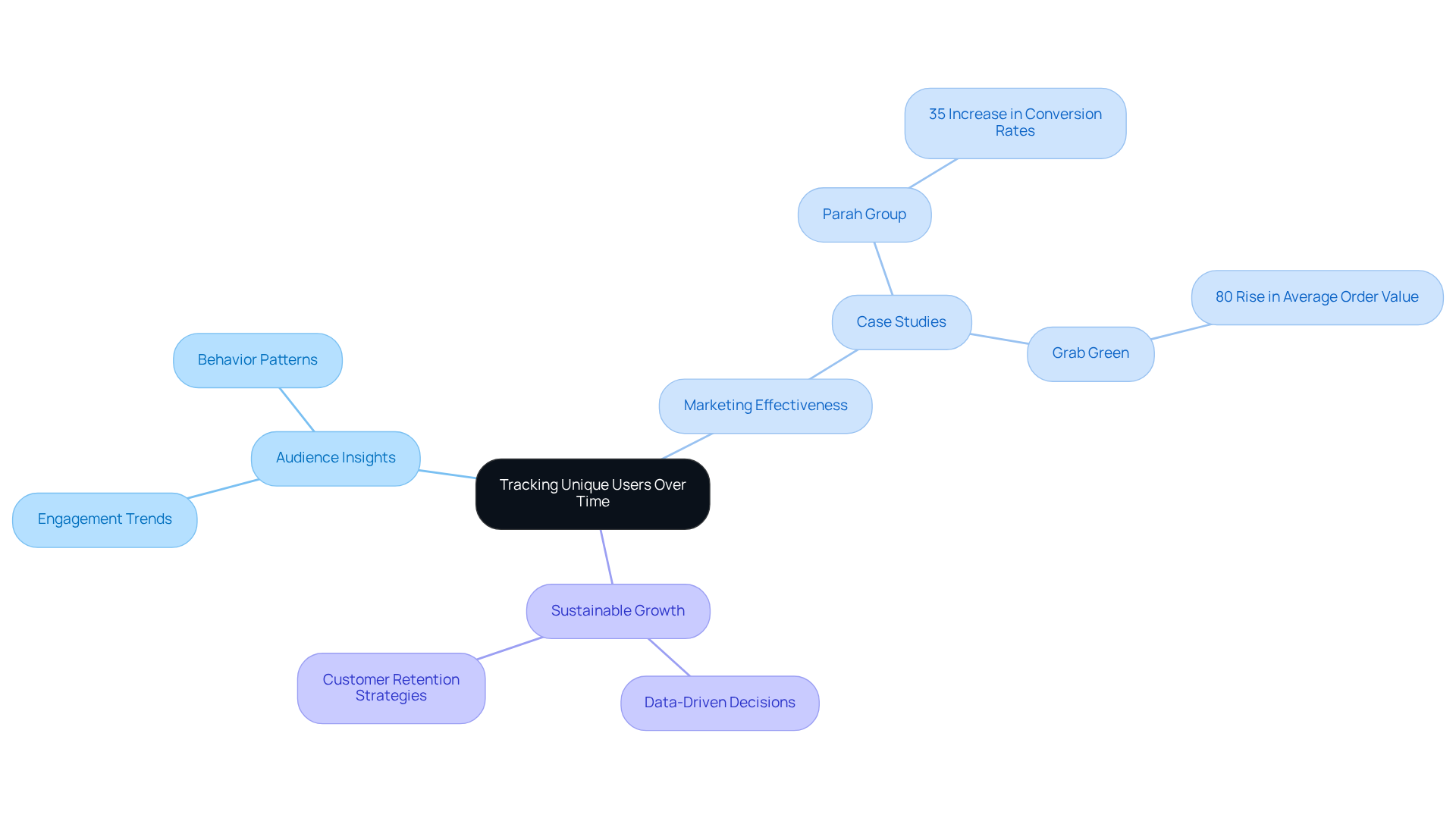
How Google Analytics 4 Calculates Unique Users
Google Analytics 4 establishes distinct visitors through a sophisticated combination of individual IDs and cookies stored in the browser. Each individual is assigned a unique identifier, enabling GA4 to meticulously track their interactions across various sessions and devices. This approach ensures that individuals are counted only once, even if they engage with the site multiple times within the specified time frame.
For DTC companies, understanding this calculation is paramount, as it directly impacts their interpretation of audience engagement and informs strategic decisions based on analytics data. By leveraging insights from GA4, companies can execute comprehensive Conversion Rate Optimization strategies that not only enhance profitability but also promote sustainable growth, ensuring that their marketing initiatives resonate with consumer behavior and preferences.
![]()
The Role of Unique Visitors in Evaluating Website Performance
In DTC companies, the evaluation of website performance relies on Google Analytics unique users, which represent the number of distinct individuals visiting a site within a defined timeframe. This metric not only signifies the site's reach but also its capability to effectively attract and engage Google Analytics unique users. By analyzing the data on Google Analytics unique users, companies can gauge the effectiveness of their marketing strategies, identify successful campaigns, and uncover areas that need improvement. A notable increase in Google Analytics unique users frequently correlates with successful outreach strategies, indicating that marketing efforts resonate with the target audience.
Furthermore, understanding distinct visitor patterns by analyzing Google Analytics unique users can lead to enhanced user experiences and improved conversion rates, as companies can tailor their strategies based on real-time insights. As one web performance analyst stated, 'Marketing efforts are much more effective when you know exactly how many people are visiting your site.' This underscores the imperative for DTC brands to leverage distinct visitor metrics to amplify their marketing effectiveness and foster sustainable growth.

Limitations of Unique User Metrics in Google Analytics 4
The metrics for google analytics unique users in Google Analytics 4 (GA4) provide invaluable insights, yet they present notable challenges. Factors such as cookie blocking, device switching, and data sampling significantly influence the accuracy of google analytics unique users. The reliance on account IDs can lead to discrepancies when users do not log in or clear their cookies, resulting in incomplete data for google analytics unique users. Analytics experts have noted that these limitations can skew the interpretation of consumer behavior, making it essential for DTC companies to understand the subtleties of their google analytics unique users data.
DTC companies face unique hurdles in effectively monitoring their customers. The evolving landscape of privacy regulations and browser settings, particularly Apple's Intelligent Tracking Prevention, complicates the collection of precise data about individuals. As Katie Rigby highlights, the dependence on sampled data in GA4 introduces an element of guesswork into analytics, which can potentially obscure the true customer journey as it relates to google analytics unique users. Moreover, the elimination of multi-touch attribution models in GA4 has left marketers questioning the efficacy of their tracking methods.
Despite these challenges, several DTC companies have adeptly navigated the complexities of distinct consumer data by analyzing google analytics unique users. By implementing robust consent management strategies and encouraging users to log in across devices, these companies have improved their tracking accuracy. Additionally, leveraging alternative analytics solutions that prioritize privacy can help alleviate the difficulties posed by GA4's limitations. As the digital landscape continues to evolve, understanding and adapting to these challenges will be crucial for DTC companies aiming to leverage distinct consumer metrics effectively.
![]()
Best Practices for Leveraging Unique User Data in GA4
To effectively leverage distinct client data in Google Analytics 4 (GA4), DTC companies must adopt best practices that are intricately aligned with comprehensive Conversion Rate Optimization (CRO) strategies. Consistent tracking of distinct visitor metrics is essential for identifying trends and shifts in behavior, empowering brands to respond proactively.
For example, Pela Case realized a 12% increase in conversion rates by harnessing GA4’s predictive audiences to target high-likelihood purchasers. Segmenting individuals based on engagement levels allows for tailored marketing strategies that resonate with diverse audience segments.
Furthermore, a holistic approach to CRO guarantees that paid ads and landing pages are seamlessly integrated, fostering significant growth and enhanced conversion rates. Utilizing custom reports provides deeper insights into individual interactions and preferences, enabling data-driven decision-making. Monitoring micro-conversions aids companies in better understanding intent, thereby refining their marketing strategies.
It is imperative to adhere to data privacy regulations during data collection and analysis to uphold customer trust. By implementing these strategies, companies can elevate their marketing efforts and drive superior performance.
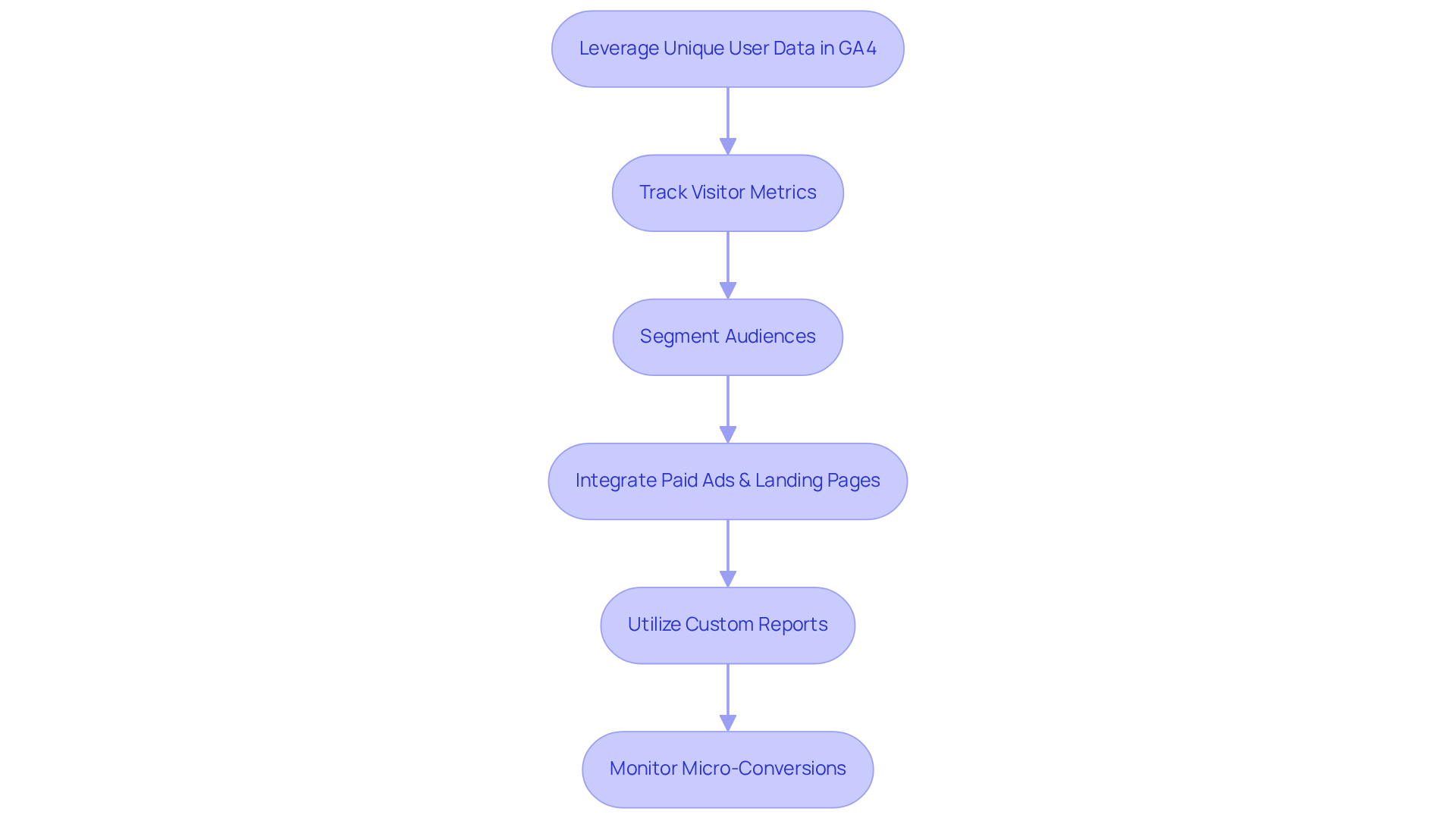
Users vs. Traffic: Key Differences Every DTC Brand Should Know
Understanding the distinction between customers and traffic is imperative for direct-to-consumer (DTC) companies. Visitors represent unique individuals interacting with a website, whereas Google Analytics unique users includes all visits, even those from the same individual. This differentiation is vital as it influences how companies analyze their analytics data. Focusing on Google Analytics unique users can reveal insights into audience growth and engagement, whereas traffic metrics reflect overall site activity. As one expert articulates, 'User Acquisition shows marketing channels that acquired your visitors and later attributes all events/conversions to that initial traffic source.' This perspective underscores the need for DTC companies to balance both metrics to develop comprehensive marketing strategies that effectively drive conversions.
For instance, a DTC company that adeptly integrates consumer and traffic metrics can identify high-performing channels and refine future campaigns. By examining the User Acquisition Report, companies can evaluate the success of their marketing initiatives in attracting new clients, while the Traffic Acquisition Report provides insights into all sessions, offering a more complete view of engagement. This dual approach not only deepens the understanding of customer behavior but also informs strategic decisions that enhance ROI and foster sustained growth.
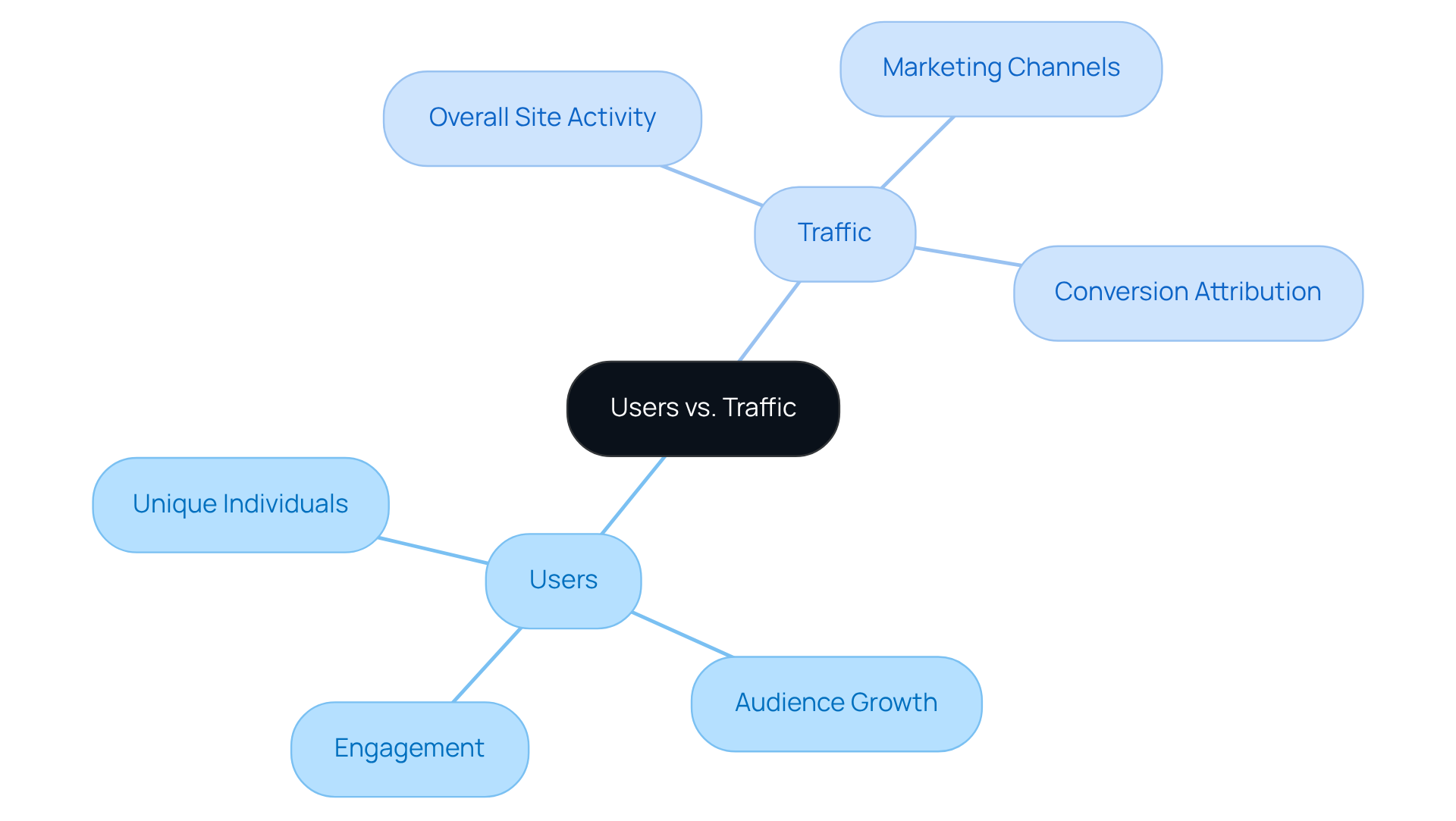
Key Takeaways on Unique Users for DTC Brand Owners
For DTC brand owners, grasping the concept of distinct individuals is vital for refining marketing strategies and boosting profitability. Consider these key insights:
- Regular monitoring of Google Analytics unique users involves consistently tracking distinct participant metrics to uncover trends that can inform your marketing decisions.
- Customer Differentiation: Distinguish between new and returning customers to tailor your marketing efforts effectively, enhancing engagement and retention.
- Understanding constraints is important, as the limitations of distinct participant metrics in Google Analytics 4 (GA4) may hinder the analysis of Google Analytics unique users and not provide a complete picture of behavior.
- Best Practices Implementation: Adopt best practices for utilizing distinctive individual data, such as segmenting audiences and personalizing content to meet their needs.
- Metrics Focus: Acknowledge the distinction between individuals and traffic to prioritize the appropriate metrics that generate meaningful insights.
By applying these insights, DTC companies can foster sustainable growth and significantly enhance their overall performance. As Eli Weiss emphasizes, enhancing strategies based on distinct client insights is essential for establishing enduring customer connections and boosting retention. Recent trends indicate that successful DTC brands are increasingly leveraging metrics from Google Analytics unique users to refine their marketing approaches, ensuring they remain competitive in a rapidly evolving landscape.
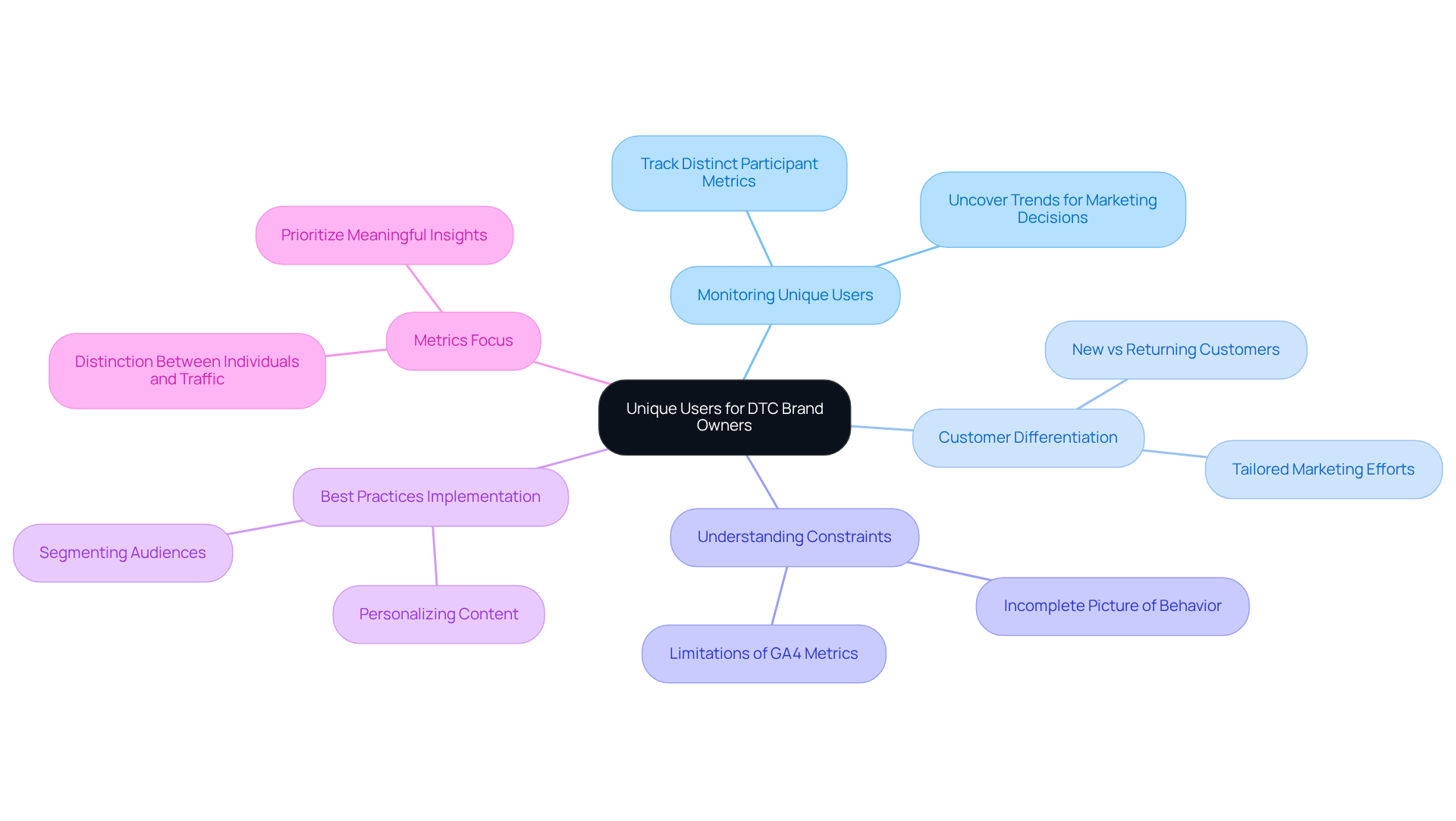
Conclusion
Understanding the significance of unique users in Google Analytics is paramount for direct-to-consumer (DTC) brands striving to optimize their marketing strategies and achieve sustainable growth. By analyzing distinct consumer data effectively, brands can tailor their approaches to meet specific audience needs, thereby enhancing engagement and conversion rates.
Key insights throughout this article underscore the necessity of:
- Differentiating between new and returning users
- Understanding the impact of unique user metrics on website performance
- Recognizing the limitations encountered when tracking these metrics in Google Analytics 4
Strategies such as:
- A/B testing
- Audience segmentation
- Implementation of best practices for leveraging unique user data
emerge as vital components for success in the competitive DTC landscape.
As the digital environment continues to evolve, it is imperative for DTC brands to prioritize the analysis of unique user metrics to refine their marketing efforts. By adopting a data-driven approach and remaining informed about the challenges and best practices associated with Google Analytics, companies can enhance customer relationships, drive conversions, and establish a robust foundation for long-term growth. Embracing these insights will ensure that DTC brands remain agile and responsive to the ever-changing consumer landscape.
Frequently Asked Questions
What is Parah Group's focus in the DTC industry?
Parah Group specializes in Conversion Rate Optimization (CRO) for direct-to-consumer (DTC) businesses, with an emphasis on enhancing customer engagement through data-informed strategies.
How does Parah Group help companies understand their clientele?
Parah Group utilizes session recordings and customer surveys to gather insights into consumer behavior, allowing brands to refine their marketing strategies and improve engagement.
Why is optimizing checkout processes important for DTC brands?
Optimizing checkout processes is critical for reducing cart abandonment rates, which enhances overall customer engagement and increases conversion rates.
What role does user-generated content (UGC) play in consumer purchasing decisions?
An impressive 93% of consumers find user-generated content instrumental in their purchasing decisions, highlighting its importance in fostering genuine engagement and boosting conversions.
How does Google Analytics 4 (GA4) define unique users?
In GA4, unique users are defined as distinct individuals who interact with a website or app within a specified time frame, helping DTC companies understand their true audience size.
What are some strategies DTC companies can use to optimize their marketing efforts?
DTC companies can enhance their marketing strategies through A/B testing and audience segmentation, which allows for tailored marketing efforts that meet the specific needs of their audience.
What is the difference between new and returning users in DTC marketing?
New users are those visiting the site for the first time, while returning users have previously engaged with the company. This distinction helps companies tailor their marketing strategies to effectively engage both groups.
What marketing strategies are effective for new customers?
New customers often benefit from introductory promotions and educational content that enhance their initial experience with the company.
How can DTC companies engage returning customers?
Returning customers typically respond well to loyalty programs and personalized recommendations that acknowledge their previous interactions.
What is the overall benefit of leveraging consumer behavior analytics for DTC companies?
By analyzing consumer behavior, DTC companies can optimize their marketing efforts, improve customer satisfaction, and foster sustainable growth through enhanced engagement and increased conversions.
FAQs











